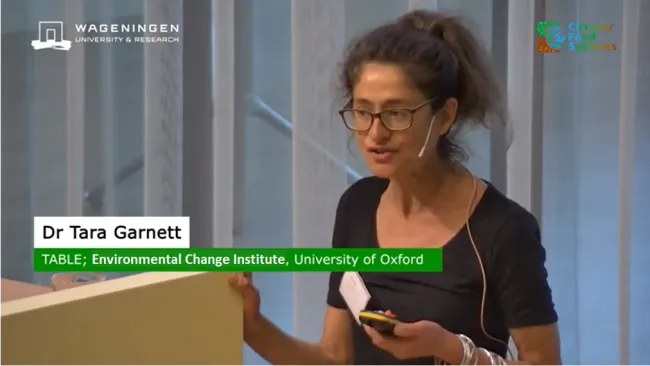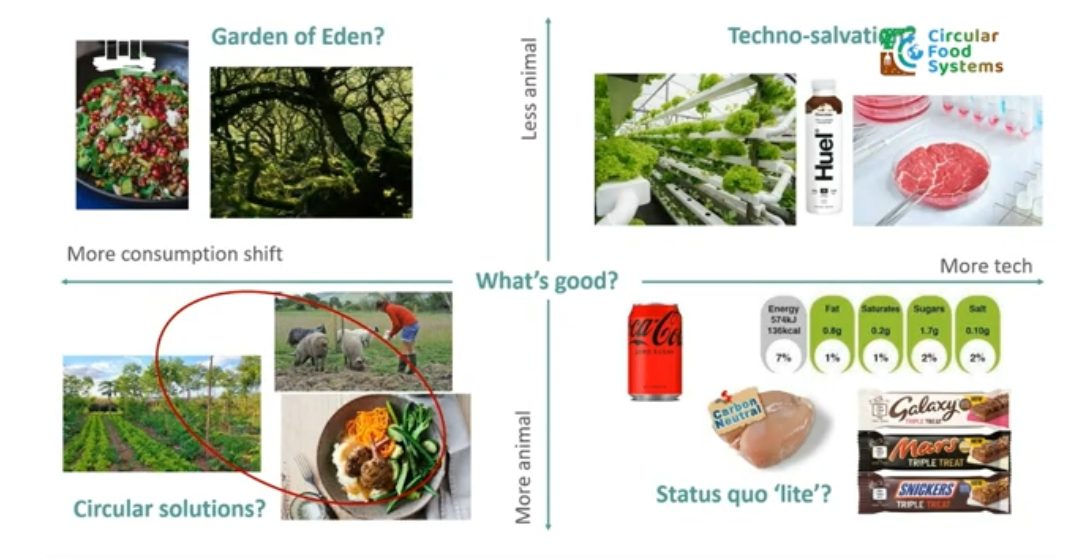TABLE’s director, Tara Garnett, gave a talk at the Wageningen University & Research (WUR) symposium on the environmental impact of food systems earlier this summer. We are summarising the talk here, because it provides a good introduction to TABLE’s approach to food system debates.

Scenarios for a future food system
Different responses to the first question can broadly be placed on two axes (see image below). On the horizontal axis there is an emphasis on technological solutions and efficiencies at one end, and a focus on the need for consumption changes at the other. At one end of the vertical axis is an emphasis on the need for, and benefits of, animals in the food system, and at the other end is reduced animal production.
These two axes create four scenarios or visions for a future good food system:
Business as usual (bottom right quadrant in image below): here we tweak and reformulate products in ways that shave off inefficiencies, but deliver the sorts of foods that consumer sales suggest we actually want. A bit cleaner, a bit healthier - Coke Zero, for example.
Tech innovation (top right): this next vision is based on same set of assumptions; we can’t change the economic system or consumption patterns, but what we can do is go further with innovation. We can produce animals in the lab through cellular agriculture, intensify our production, and achieve efficiencies so great that we could effectively achieve landless production systems and get all the nutrients we want through lab-based pharmaceutical work. This vision is predicated on a land-sparing model where we deliver the foods that we apparently want in as small a space as possible.
Circular solutions (bottom left): a completely different way of thinking about what we want is to suggest that we use animals as recyclers of nutrients in the food system. This implies a quite different form of agricultural production and a drastically different mode of consumption. It is based on the idea that we can and should change, and perhaps we can live well by consuming less.
Plant-based (top left): the fourth approach is similar to the previous one, but questions whether we need animals in the food system at all.

These types of scenarios can inform discussions about the sorts of change we want, and many of us will gravitate towards one of the four scenarios. This symposium was broadly supportive of circularity in the food system, but this is not the only future that people are arguing for.
Once we know what future(s) we are moving towards, the next step is to work out how to change the food system. This system is incredibly complex, and influenced by everything from foundational biology and family upbringing, to personal beliefs, income, access and affordability. Further influences include planning policy, agribusiness and trade systems, as well as the economic, social and political paradigms that influence consumption but have nothing to do with the food system itself.
How do we achieve change?
Ideas about change are influenced by many different things, but this talk singles out two in particular:
- Ideological beliefs: people have different opinions about what change is legitimate (“governments should govern” vs “governments should stop interfering in the market”. As well as about what change is necessary (“incremental change is sensible” vs “incremental change won’t get us far enough, fast enough”). There are also differing opinions as to what counts as ‘real’ change (“we need to be less greedy” vs “we need to have what we want in greener, cleaner ways”).
- How we are trained to understand the world: our training or background has a strong influence on how we interpret and address the need for change (for example, an engineer vs a historian, a modeller vs a policy maker). These different ways of seeing the world will influence not only how you approach the problem, but what you see as the appropriate context of change and therefore where you focus your energy (e.g. through financial or legal institutions, consumer change, industry, etc.)
Change itself is approached in a number of ways. Some throw more knowledge or research at the issue, hoping that eventually the sheer mass of evidence will help people to see the light. Others call for (dis)incentives such as taxes and marketing, or try to effect change by speaking to people’s emotions (e.g., through campaigns and advertising). Another approach is to create change through change (e.g., through regulation, behavioural ‘nudges’ and product innovation).
TABLE's approach to understanding debates
We need more focus on dialogue and discussion that brings in a wider set of stakeholders; this is the goal of Omnia, WUR’s Centre for Dialogue (the venue of this symposium), it’s also our goal here at TABLE.
No single approach will address all of the issues in the food system, and given the scale of the challenges we face, Tara’s own conclusion (based on all of the above!) is that we need to do everything we can, everywhere at once. This requires an understanding of where others are coming from, and much more experimentation and leadership.
To understand the ideas that people bring to food systems change, and to move past disagreements and polarisation, we need to understand the values and assumptions that inform these proposals. This is the role we take at TABLE, which is why there is as much emphasis in our work on the evidence, assumptions and ethical positions that inform people’s arguments as there is on the synthesis of information about the issues at hand.
This talk can be viewed online: From models to reality (via visions, values and assumptions)
More about the symposium
At this event, almost 600 researchers, students, entrepreneurs and representatives of NGOs joined forces to consider a new food system setup. We’d also recommend the other presentations, which you can view online:
- What a fully circular European food system could look like (Hannah Van Zanten).
- Strategies towards more sustainable food systems (Anita Frehner).
- The role of seafood in a sustainable food system (Friederike Ziegler).
- Estimating environmental impacts of food products (Michael Clark).
- Degrowth in the food system (Benjamin Bodirsky).
Following presentations that analysed food system problems and considered pathways towards solutions, Tara took a step back to explore two questions:
- What do we actually want from our food system, and what does this look like?
- What are the assumptions that are being made about this future, and how do we get there - what change is needed?




Comments (0)